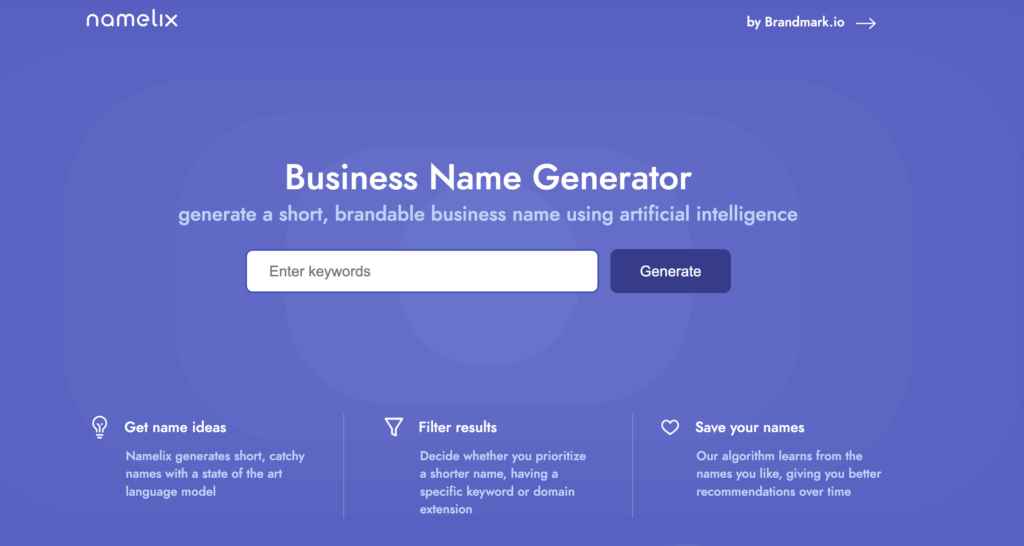
There’s a lot to consider when naming a start-up, and choosing the right name for your start-up is crucial to its success. It’s not only about coming up with something that’s catchy, or memorable. The name of your start-up needs to represent what your company is all about, and it needs to be able to grow with your business. Embarking on a new business venture can be intimidating, and unfortunately, many start-ups fail, because the name given to them is too limiting.
Your start-up’s name should be:
– Be catchy and memorable
– Accurately represent your brand
– Be able to grow with your company
– Not be limiting
Follow these steps and you’ll be well on your way to finding the perfect name for your business.
First, determine whether a business name is already in use.
On the ASIC website, you can check the availability of business names in Australia. The cost of registration and renewal is A$37 per year or A$88 for three years, through which, you are able to update or transfer your business’s name. If you are considering registering your business name as a trademark, check IP Australia to find any previously registered trademarks.
15 Tips and Steps to Naming a New Venture

Step 1: Comprehend the Psychology of a Name
Ideally, the name of your startup will represent you when you are not present. What people think when they first hear the name of your startup is significant. That first impression; what people instantly think of as your startup upon hearing or seeing its name, and the things they identify with it, are very important.
With any firm or startup, you must recognise that regardless of the name, there will be individuals who have bad perceptions about your business. A minority of individuals disliking your company’s name is nothing to be concerned about.
Don’t be scared to have a somewhat of an edgy name if you are a company that wants to be immediately identifiable. However, do avoid crossing the line between being edgy and contentious.
Step 2: Being Aware of What Not to Do
Before you can comprehend what to do, you must comprehend what not to do. Here are the three major no- no’s:
1) Names that are Hard to Pronounce
The most important criterion when choosing a name for your business is that it must be easy to say, spell, and remember.
If people have difficulty pronouncing your name, it is highly likely that they will avoid saying it. As part of an effort to be creative or unique, you should avoid employing a misleading intentional typo in your name. It is extremely typical for names with intentional misspellings to generate more confusion than fascination.
Try applying the Packed Bar Theory to your name if you like it, but are unsure if it’s the right one. If you had to explain the name of your startup to a buddy in a crowded bar, would it be easily understood? A restaurant with the name “Sam and Ella’s” would be an example of a name that fails the crowded bar test. When overheard in a busy pub, this moniker could sound like “salmonella”. It is unattractive and unappealing. Therefore, it is crucial that you double-check that your brand name can be accurately understood after a single hearing.
Potential customers are more likely to recall business names that are straightforward to speak and spell. When satisfied consumers recommend your company to their family and friends, they act as brand ambassadors. Choosing a smooth, uncluttered name simplifies the sharing process for your clients.
2) Unoriginal Names
While it is always important to have a descriptive name that informs your audience of what your business offers, names that are overly descriptive tend to be dull.
‘Certified Office Stationery Items LLC’, for instance, is a fairly descriptive name. The audience has a thorough knowledge of the things sold by the business based solely on the name. The name, however, is not unique. It is overly descriptive, which renders the name dull and conventional. This type of title is out of date and cannot compete in today’s market because it will not attract or interest customers.
3) Long Names
Long names present numerous challenges. The awkwardness of a lengthy name will deter many prospective customers and clients, as lengthy names are accompanied by lengthy URLs.
You should also consider future social media handles that you may want for your brand. Twitter handles are limited to 15 characters, so ensure that your name fits, or can be reduced.
Step 3: Language
Don’t limit yourself to English; foreign words can also be effective, for example, “Ubuntu”. However, be sure to avoid using a name or word that is spelt differently than how it sounds.
Step 4: Use Compound Names
In the start-up world, compound names appear to be especially popular. They’re great for sending a message and telling people about your company without giving everything away. For example, the term “Instagram” is derived from the terms “Instant” and “Telegram.”
Pinterest, on the other hand, is derived from the words “Pin” and “Interest.”
A compound name can be an excellent tool for drawing attention to some of the most important aspects of your company or identity while allowing for future expansion.
Step 5: Made up words
When you choose a title or domain name for a startup, you are defining a company that is still in its early stages of development. When you’re not sure what the future holds, it’s sometimes easier to choose a completely new word.
“Klarna”, for example, is currently one of the world’s largest startups. The use of a completely made-up word implies that the company is free to experiment with new services and products as it goes, all while developing its own identity.
Step 6: Know your Objective
If you have not already established the goal of your firm, you should spend a few minutes defining your company’s aspirations and the promise you make to your customers. It is a wonderful idea to choose a name that reflects your mission and ideals.
If you have not yet identified your objective, you may find the following templates useful:
We assist A (Customer) with B (Problem) by performing C (Solution). For instance, we assist email marketers in creating newsletter emails by providing them with a fully responsive and user-friendly email design tool.
Alternatively, (Notable Organisation) for (New Domain). Airbnb for Supercars, or, Tinder for dogs, for instance.
Step 7: Determine what your Buyer Persona is
Before naming your startup, you must define your buyer persona in order to gain a deeper understanding of your target market.
To accomplish this, consider listing the following attributes of your ideal customer on a sheet of paper:
– Context and demographics: History, sex, age, position, organisation, and income
– Activities and interests
– Short-, medium and long-term objectives
– Daily obstacles
– Common objections and greatest concerns
– Marketing messaging
– In-flight pitch
Step 8: Brainstorming Keywords
Create a list of keywords related with your startup, then, begin to play with them. Create variants, transform them, and then combine two of them.
It is recommended to limit startup names to two syllables, as they are easier to recall. We need to simply consider some of the world’s largest corporations to grasp this:
Sony
YouTube
The combination of two keywords can result in either an explicit or an implicit name.
Explicit refers to a corporation whose name expresses its goal explicitly. Facebook is the ideal example, as indicated by the combination of the keywords Face and Book. Implicit refers to a name that, simply by reading it, does not convey the nature of the company. Tesla is a superb example.
Step 9: Selecting a Shortlist
Once you’ve compiled a list of names you like, it’s time to check the names are available not only on app store and play store but also on all social media platforms. From our own experience, we have seen clients choose a business name that is not available on social media platforms. To avoid this please ensure your domain or business name is available across all social media platforms before choosing it. To avoid this, we suggest using:
Namecheckr: Social and domain name availability search
BrandSnag: Check domain name, social media handles and gaming username availability
Step 10: Name Generators
We recommend using a simple name generator to folks who are uncertain and encountering too many problems when naming something. These tools will provide the best possible name depending on the parameters you enter. Fortunately, we’ve selected our favourites to help you find a name faster.
Namelix generates brandable, concise names that are pertinent to your business or startup idea. Each time you bookmark a name, their artificial intelligence computer learns your tastes and provides you with better recommendations over time.
NameSnack uses machine learning and the most effective naming strategies to generate distinctive startup names.
BrandBucket: This generator provides more than 50,000 pre-made and ready-to-use brand names.
Veromo: Search for an ideal business name, then find your matching domain name and social media handles.
Step 11: Legal considerations
Before you begin your search for the ideal business name, you should have a clear understanding of the type of business structure you will have. This is crucial because the rules for registering a business name differ based on the form of your company.
If your business is a corporation, you must register the business name when you form the corporation.
You must register your business name with the ASIC if you are a lone proprietor or in a partnership unless your firm is named after you or your partner.
Checking to see if the business name is already in use is another obvious step when creating a company.
Technically, until a business name is registered as a trademark in Australia, it can be utilized by several entities. In light of the brand value that your business name represents, it should be distinct and easily distinguishable from others.
Step 12: Ask Your Audience, Family and Friends
Name validation from your audience is vital, as they will not hesitate to provide you with constructive criticism. Using an online survey to obtain feedback from your consumers is a good strategy.
Keep in mind that it can be dangerous to test your business name on your friends and family. But if you insist on doing it this way, make sure they have no difficulty expressing honestly, how they truly feel about the name, and if they don’t like it.
Step 13: Try not to limit your growth
All businesses want to grow, but startups are often destined to develop much faster than their competitors. Just because you have a specific vision for your company now, does not preclude it from changing and evolving over time.
Even if you want to be descriptive when naming your startup, try to think of the big picture. For example, the successful startup “WhatsApp” employed a name that alludes to what the company does; it helps you communicate with your friends or check “what’s up” with them.
The name does not, however, describe an exact function, giving the company room to introduce new concepts and features, such as “WhatsApp Business” and video communication.
Step 14: Be Unique
Every company name should be distinct. Consider some of the most well-known brands and company names in the world; they are all highly personalised and relevant to the brand identity that the organization wishes to establish.
However, as a startup, it is especially important to demonstrate your uniqueness.
You must persuade customers, investors, and potential employees that you are doing something novel and interesting in your market in order to gain widespread support. If your company name sounds like a million others, you’re not going to make a good first impression.
If you’re having trouble coming up with a good name, do some competitor research and see what kinds of titles other businesses in your industry are already using.
Step 15: Purchase the Domain Name and Register Your Trademark
You have reached the final level. Your company is on the right path. Now, it’s time to purchase the domain. Visit your preferred domain registrar and, if available, purchase the .com, .net, .org, and any other desired domain extensions. If the .com is available, it should be prioritised, because customers are more familiar with it.
Register your firm on all social media platforms. Whenever possible, register using the same name you’ve picked for your business.
Last but not least, register the company’s name as a trademark. In some nations and states, this can be accomplished by filing an internet application in a matter of minutes and without the assistance of an attorney. This can cost between $250 and $350, and you must provide the necessary details. In some instances though, you will need the assistance of a specialist.
Examples of Startup Naming
The Boring Corporation
The inspiration for the name came from Elon Musk’s experience living in California, where traffic is famously awful. He argued that commuting underground through tunnels would be safer and faster than squeezing people onto limited-capacity freeways that provide several safety problems every day.
With The Boring Company, one can find fun and wit. When you hear the name, you laugh a little on the inside and cannot help but wonder what the startup does.
Brandless
Brandless is an e-commerce business that sells food, cosmetic products, and home goods. People today are so accustomed to brand names such as Nike, Gucci, Apple, and the list goes on. Having a startup named Brandless will undoubtedly make you memorable amongst other competitors.
Bodega
Bodega, or Stockwell as it is now known, is a vending machine firm. The name was chosen to pay homage to the corner businesses that many people grew up with. Ironically, the same people who discovered the company online viewed their name as derogatory almost immediately.
When facing blowback, you must quickly accept what went wrong, unlike Bodega, which took 10 months to address the issue and eventually changed the startup’s name. The founders’ Paul McDonald and Ashwath Rajan did not intend to offend anyone, but when choosing a name, it is important to consider whether or not it may be objectionable to others. Additionally, you must comprehend what your name represents in other countries. Each country has its own set of beliefs and customs, which you must take into account respectfully.
Final Thoughts
Naming a startup company is a complex process that necessitates a great deal of focus, attention, and ingenuity. If you ask someone how to name a startup, they’ll usually give you a wide range of suggestions, ranging from researching for hours to using word clouds. However, most startups have undergone their own specific and personalised approach to naming themselves.
Don’t be surprised if your ideal company name doesn’t just “come to you” after you’ve landed on an excellent business plan idea. Most names need far more effort than many businesses realize and new naming is notoriously difficult due to the adaptability of startup enterprises. If you don’t name your startup right, you can find yourself back at the beginning.
The most crucial thing you can do is give your startup’s name the attention it deserves. Don’t rush through the naming process, or settle for a placeholder name because you want to get your product or service to market as soon as possible.
Remember that startup names not only assist to define your brand, but also help to attract the consumers, workers, and investors who will help your firm develop.
Now, the arduous and time-consuming chore of naming your startup is now only a few simple steps away from completion! Contact us for more information on how to name your startup successfully.
